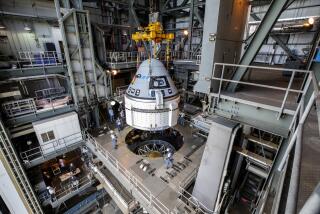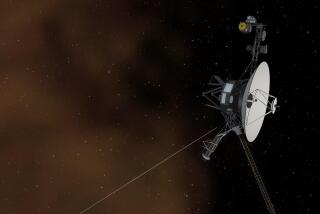Still Spirited, but Starting to Show Its Age
Showing its advancing age, NASA’s Spirit rover has developed a problem in one of its six wheels but has overcome a communications glitch that was preventing it from receiving commands from Earth, mission controllers at the Jet Propulsion Laboratory in Pasadena said Tuesday.
The right front wheel is using two to three times more electricity than the others, suggesting that the wheel is failing, team members said. Also, Spirit’s radio receiver was having trouble homing in on the right frequency to get its daily commands.
Spirit, which landed on Mars in January, has lasted nearly twice its designated lifetime. It “has gotten a little hard of hearing, due to temperature, and has arthritis in one of her joints,” said mission manager Mark Adler.
But even with these problems, the rover still finished its 2-mile trek across the Martian surface to the Columbia Hills and discovered geological formations that were “nothing short of remarkable,” said Larry Soderblom, a science team member from the U.S. Geological Survey in Flagstaff, Ariz.
The rover team has worked around Spirit’s communications troubles by transmitting commands on additional frequencies so the robot can home in on the transmission more easily. To circumvent its motor problems, the team may have Spirit drive on five wheels or use the damaged wheel only during particularly difficult exercises, such as climbing a steep hill.
The wheel’s motor may last for only another 600 feet or so, but the team is confident Spirit can run with as few as three wheels powered, Adler said.
As it limped to the Columbia Hills, Spirit encountered rock formations resembling a rotten loaf of bread with just the crust remaining, Soderblom said. He added that although wind or water might have eroded away the “bread,” it’s likely that water was involved in forming the crust.
Among the strangest things the rover has encountered are what the scientists called “hooded cobras.” They appear to be the resistant remnants of the “crusts,” standing above the surface like “small canopies,” Soderblom said.
Before it reached the cobras, Spirit trained its sensors on a rock dubbed “pot of gold” that contained hard nodules embedded in a softer material. They resembled the so-called blueberries that the rover Opportunity discovered on the other side of Mars.
Meanwhile, Opportunity has nosed into a large crater called Endurance. The rover has its sights on a layered rock face, which may have been created by water over time.
More to Read
Sign up for Essential California
The most important California stories and recommendations in your inbox every morning.
You may occasionally receive promotional content from the Los Angeles Times.









